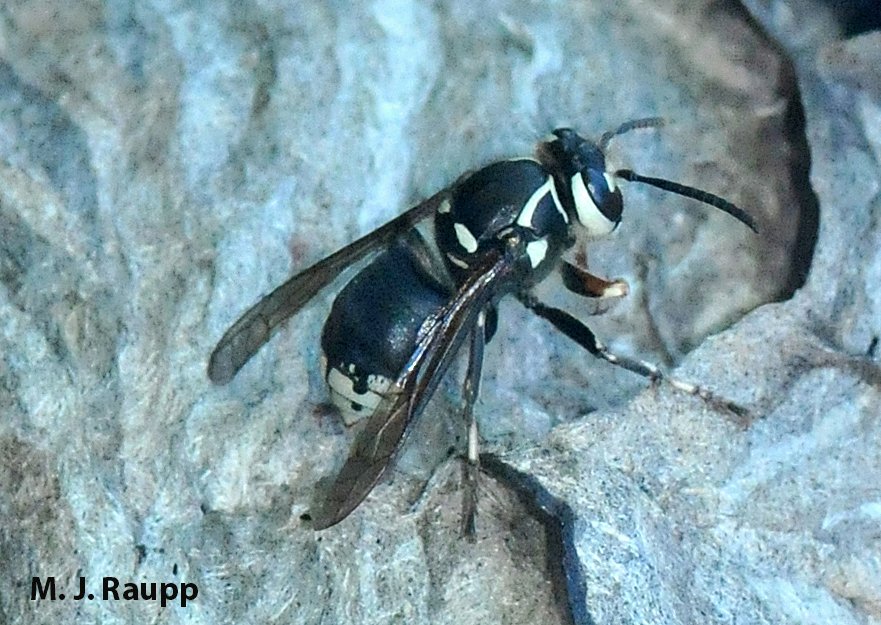
Baldfaced hornets survive winter’s chill by hunkering down beneath the bark or in decomposing wood of fallen trees. Ice-nucleating compounds manufactured by the hornet allow water molecules to freeze outside rather than inside cells where ice crystals could be lethal.
The past couple of weeks we have explored the strategies insects use to deal with chilly winter weather in temperate parts of the country, including the DMV. We learned that some butterflies and true bugs (Hemiptera) employ a snow-bird strategy and simply migrate south to warmer regions to avoid freezing to death. But not everyone gets out of town. Last week we met the banded woolly bear caterpillar and its cousin the giant woolly bear. Think about the lowly banded woolly bear caterpillar. How long would it take for these caterpillars to wiggle their way from the DMV to Florida to avoid freezing to death? That doesn’t happen. So, what do they do? Through eons of trial and error, woolly bear caterpillars and several other species of insects have evolved a strategy called freeze tolerance. Here’s the backstory.

After finishing the season’s last meal, banded woolly bear caterpillars move to protected locations under ground cover, fallen leaves, or bark of fallen trees to overwinter. Cryoprotectant compounds such as glycerol produced by the caterpillar act like antifreeze, preventing its blood and cells from freezing and allowing the caterpillar to survive subfreezing temperatures.
Insects and many other animals like reptiles and amphibians are ectotherms. Unlike humans, other mammals, and birds whose temperatures stay more or less constant, ectotherms rely primarily on ambient temperatures to heat or cool their bodies. Most insects that winter-in-place where freezing temperatures prevail enter a state of dramatically reduced development called diapause. Diapause is triggered by environmental cues such as changing food availability and quality, changing day length, and cooling temperatures. These cues initiate physiological processes to acclimate in preparation to endure winter’s cold. When temperatures drop below freezing, water molecules inside cells throughout the insect’s body can form lethal ice crystals that can destroy cells and result in a chilly death. The lowest temperature an animal reaches before freezing is called the super cooling point (SCP).
Some Freeze tolerant insects produce compounds called ice-nucleating agents. These agents cause ice crystals to form rapidly and harmlessly in the hemolymph at relatively high temperatures. Water molecules move from within cells to the hemolymph where they also freeze. This prevents ice crystals from forming inside cells where they could rupture cells and cause cell death. Insects like bald-faced hornets employ this clever tactic. A second group of compounds called cryoprotectants have been discovered in several freeze tolerant insects like our friend the banded woolly bear, as well as the spring field cricket. These compounds include sugar alcohols such as glycerol, sorbitol, and trehalose, and amino acids like proline. Cryoprotectants act in the same way as ethylene glycol in the radiator of your car, which prevents your engine coolant from freezing. Cryoprotectants prevent ice formation, keeping vital fluids liquid and thereby allowing the supercooling point of an insect to drop dramatically.
Insects living in regions where winter temperatures dip below freezing evolved clever ways to avoid a chilly death. Some species like overwintering baldfaced hornet queens produce compounds that hasten the formation of ice crystals in their blood. This prevents ice crystals from forming inside cells where they would lethally rupture cells and kill the queen. Another freeze-tolerant insect, the spring field cricket, is close kin to the fall field cricket we visited in a previous episode. Banded woolly bears that we met last week don’t employ ice-enhancing compounds. Instead, they produce antifreeze-like compounds, cryoprotectants including glycerol and sorbitol. These protectants prevent their cells and blood from freezing at subfreezing temperatures that are normally encountered in their habitats. This allows woolly bears to chill-out rather than die.
Of course, for all insects there will be a minimum temperature at which life will be impossible. This varies both within and between insect species and depends on a variety of environmental conditions leading up to and during the seasons of subfreezing weather. So, how low can freeze tolerant insects go before they freeze to death? One tiny fly that makes galls on goldenrod in North America can survive temperatures of -40 degrees Fahrenheit or less. Now that’s one cool fly!
Acknowledgements
The following articles provided fascinating insights into the overwintering and anti-freezing strategies of insects: “Insect antifreezes and ice-nucleating agents” by John G. Duman, “Cold Hardiness of Insects and the Impact of Fluctuating Temperatures” by Ashley Dean and Erin Hodgson, “Freeze tolerance and cryoprotection in caterpillars of the giant leopard moth (Ecpantheria scribonia Lepidoptera: Arctiidae)” by Jack R. Layne Jr., “How crickets become freeze tolerant: The transcriptomic underpinnings of acclimation in Gryllus veletis” by Jantina Toxopeus, Lauren E. Des Marteaux, and Brent J. Sinclair, “The sub-lethal effects of repeated freezing in the woolly bear caterpillar Pyrrharctia Isabella” by Katie E. Marshall and Brent J. Sinclair, “Cold-hardening of the ground beetle Carabus granulatus L. (Coleoptera:Carabidae)” by Irja Kivimägi, Angela Ploomi, Anne Luik, Katrin Jõgar, Ivar Sibul, and Aare Kuusik, “Landscape effects on the thermotolerance of carabid beetles and the role of behavioral thermoregulation” by Lucy Alford, Sacha Roudine, Jean-Sébastien Pierre, Françoise Burel, and Joan van Baaren, “The role of ice nucleators in the frost tolerance of overwintering queens of bald faced hornet” by J. G. Duman and J. L. Patterson, “Changes in Chemical Composition and Accumulation of Cryoprotectants as the Adaptation of Anholocyclic Aphid Cinara tujafilina to Overwintering” by Roma Durak, Joanna Depciuch, Ireneusz Kapusta, Joanna Kisała, and Tomasz Durak, “Cold Hardiness of the Woolly Bear Caterpillar (Pyrrharctia isabella Lepidoptera: Arctiidae)” by Jack R. Layne Jr, Christine L. Edgar, and Rebecca E. Medwith, and “Insect overwintering in a changing climate” by J. S. Bale and S. A. L. Hayward.
No comments:
Post a Comment